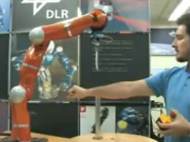Are robots with knives around humans a good idea?
 This article might be interesting for all of our readers concerned about their security around aiding robots. German researchers performed a series of stabbing, puncturing, and cutting experiments in order to understand the biomechanics of soft-tissue injury as well as to test a robot internal collision-detection system that could prevent or at least minimize injury.
This article might be interesting for all of our readers concerned about their security around aiding robots. German researchers performed a series of stabbing, puncturing, and cutting experiments in order to understand the biomechanics of soft-tissue injury as well as to test a robot internal collision-detection system that could prevent or at least minimize injury.
The experiments involved the DLR Lightweight Robot III, or LWRIII, a 7 degrees-of-freedom robot manipulator with a 1.1 meter reach and moderately flexible joints. The robot, which weighs 14 kilograms, is designed for direct physical interaction and cooperation with humans. They fitted its articulated robotic arm with various tools (scalpel, kitchen knife, scissors, steak knife, and screwdriver) and programmed it to execute different striking maneuvers.
Researchers Sami Haddadin, Alin Albu-Schaffer, and Gerd Hirzinger from the Institute of Robotics and Mechatronics, part of DLR, the German aerospace agency, in Wessling, Germany, used a block of silicone, a pig’s leg, and at one point one of them (Haddadin) used his own bare arm in a demonstration of the collision-detection system.
The researchers performed two types of experiments: stabbing and cutting, testing the different tools striking at various speeds, with and without the collision-detection system active. In most cases, the contact resulted in deep cuts and punctures, with potentially lethal consequences. As you might have expected, the collision-detection system was able to reduce the depth of the cuts and in a few cases even prevent penetration altogether.
Although the robotic arm has a force-torque sensor on its wrist, this sensor was not used in the collision-detection system. It only served as a measurement reference in the experiment. “The collision detection and reactionis based on a very good dynamics model of the robot and the fact that, unlike other robots, we have torque sensors and position sensors in every joint,” Haddadin said.
With the dynamics model (which includes rigid body dynamics, joint elasticity, and motor model) and the sensor measurements, the robot can detect a collision nearly instantaneously. The control system relies on a “nonlinear disturbance observer” and it doesn’t require any additional external because it relies only on the internal capabilities of the robot.
This is the first study to investigate soft-tissue injuries caused by robots using sharp instruments. Previous studies by the same researchers, as well as other groups, have focused on blunt collisions involving non-sharp surfaces. It is a good step toward research of safety systems which would enable integration of safe robots capable to handle various tools without the risk of injuring humans in its surroundings.









Leave your response!